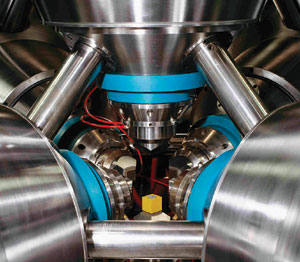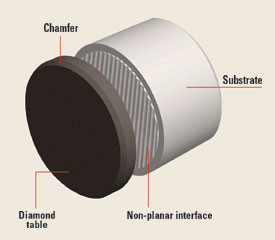New Bit Designs
Diamond cutters: Changing the face of the drilling industry
Over the past decade, polycrystalline diamond compact cutters have transformed the drilling industry by prolonging bit life, improving drilling economics and making it possible to drill more demanding formations.
Ken Jensen, US Synthetic Corp., Orem, Utah
Over the past 32 years, polycrystalline diamond compact cutters (PDCs) have dramatically changed the oil and gas drilling industry. When the first PDCs for drilling were introduced in 1972, they were considered an interesting experiment. By the end of 2003, fixed cutter PDC bits made up 45% of the total bit market, and fixed cutter PDC bits had doubled their share of the market in just over a decade.
Most industry experts expect this impressive growth to continue. This remarkable success story is largely the result of continual improvements in PDC and bit technology over the past decade. Today, PDCs offer bit manufacturers and drillers a flexible, durable and cost-effective option for drilling in the most challenging conditions. As a result, PDC technology has contributed to the growth of the fixed cutter bit market, improved drilling efficiency and saved drillers millions of dollars in drilling costs.
Over the past several years, PDC technology has made significant contributions to the success of many significant drilling projects. In the Rockies, advances in PDC technology have made it possible to drill the Almond and Mesa Verde formations with PDC bits. In East Texas, PDC fixed cutter bits are now used to drill the Travis Peak and Cotton Valley formations, saving the operator trip costs associated with changing the PDC bit for a rolling cone bit.
In the Tonkawa formation in Oklahoma, an area that has traditionally required rolling cone bits, PDC fixed cutter bits can now be used. And the Rock Creek area of Western Canada, another traditional rolling cone bit region, now features substantial PDC fixed cutter bit drilling. These difficult drilling areas – and many others – are being drilled using PDCs, because the technology has evolved to the point where it can clearly offer better performance, longer life and better economics than traditional rolling cone bits for a wide range of applications.
A HISTORY OF PDC TECHNOLOGY
The first PDCs were introduced decades ago as a replacement for natural diamonds. These early cutters lacked toughness, were generally limited to the softest drilling applications and required specialized bit designs and controlled drilling parameters. Over the years, aggressive innovation and improvements to the process have steadily increased the durability, impact resistance and abrasion resistance of PDCs. Now, PDC bits provide one of the fastest, most durable and most cost-effective drilling options.
Today's relatively advanced, durable designs are the result of constant improvements over the past 30 years. During the 1980s, most PDC research and development efforts revolved around finding reliable ways to attach PDCs to fixed bits and investigating drilling applications that were suitable for the brittle nature of diamond. More recently, PDC and bit companies have shifted their focus to broadening the application of diamond and extending its durability by tailoring the abrasion and impact resistance of the cutters to the particular needs of different applications.
Many different companies have contributed to the development of PDCs. Diamond Innovations (formerly GE Superabrasives), Element Six (formerly DeBeers Industrial Diamond) and Megadiamond were all early diamond-for-drilling pioneers. And US Synthetic, which began focusing exclusively on PDCs in 1991, has contributed many of the more recent innovations that have made PDCs an even more durable, cost-effective option.
ANATOMY OF A PDC
Today, PDC inserts consist of many individual diamond crystals bonded together in a single mass, which is then bonded to a tungsten carbide base, or substrate. This sintering process occurs at the very high temperatures and pressures at which diamond becomes thermodynamically stable – roughly 1,400°C and nearly one million pounds per square inch (psi). A specialized press is used to create these extreme conditions, which mimic the temperatures and pressures that create natural diamonds deep within the earth.
The process requires tungsten carbide anvils to apply pressure to a specially created cell assembly that holds the unsintered diamond powder and substrate. A miniature single-use furnace inside the cell produces the necessary heat. One type of press is a cubic press, in which a cubic cell assembly is pressed between six anvils, Fig. 1. These massive cubic presses generally stand approximately 9 ft high and weigh roughly 40 t.
 |
Fig. 1. A cubic cell assembly (yellow) containing diamond powder is loaded into a cubic press.
|
|
After the high temperature/ high pressure (HTHP) sintering reaction is complete, the rough PDC is shaped to the bit manufacturer's specifications, typically through a series of grinding and finishing operations. Because diamond is the hardest known material, this finishing process requires diamond grinding wheels. After the manufacturing process is complete, PDCs are typically brazed into fixed cutter bits and press fit into rolling cone bits and hammer bits.
Most PDC inserts are cylindrical, with approximately 2 mm of diamond at the cutting edge. A customizable angled chamfer on the cutting edge balances the durability and sharpness of the PDC – a more pronounced chamfer generally results in more durability but slower drilling. Chamfers are nearly always tailored to meet the unique needs of a specific application. A non-planar interface between the diamond cutting surface and the carbide substrate allows the two materials to bond together both mechanically and chemically. This interface, also customizable, manages the residual stresses that exist between diamond and carbide, Fig. 2. 
 |
Fig. 2. Basics elements of a fixed cutter PDC.
|
|
|




